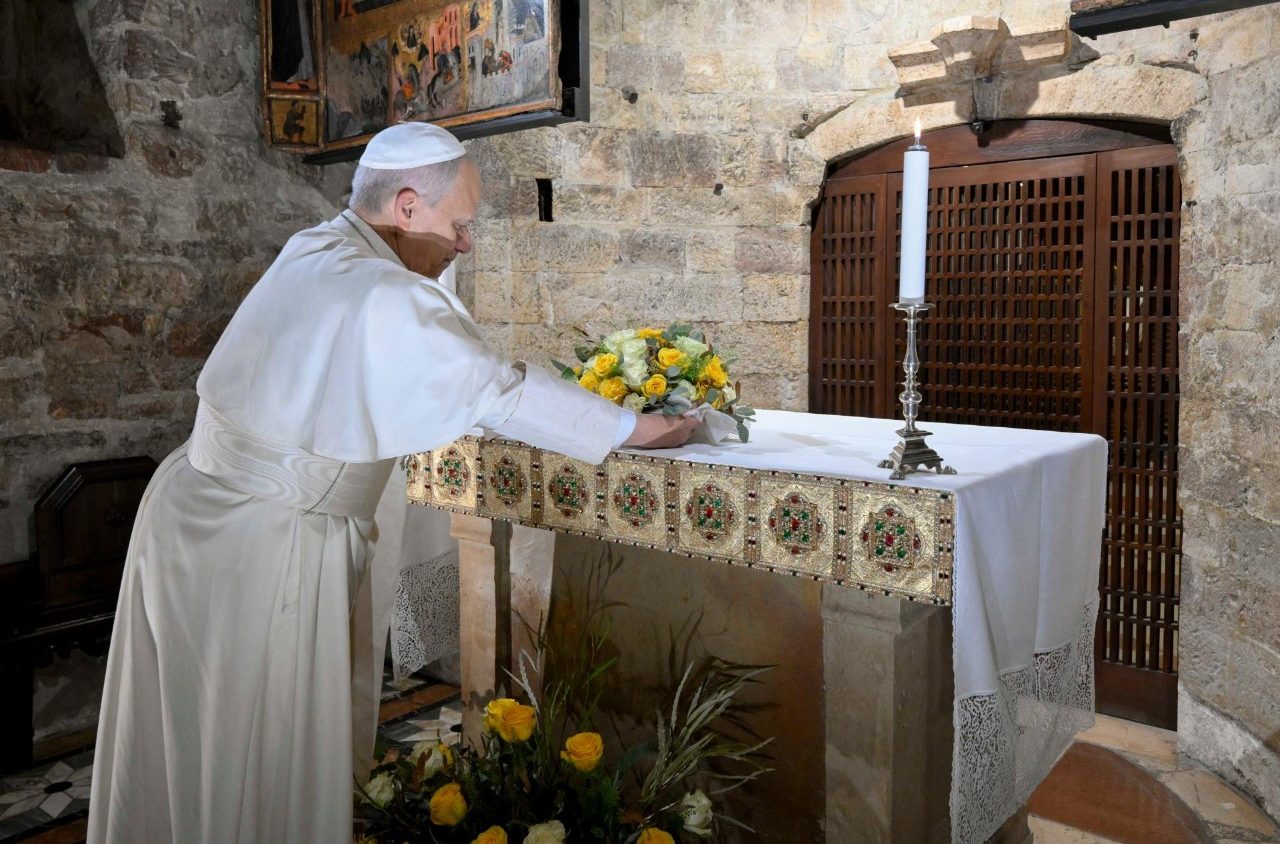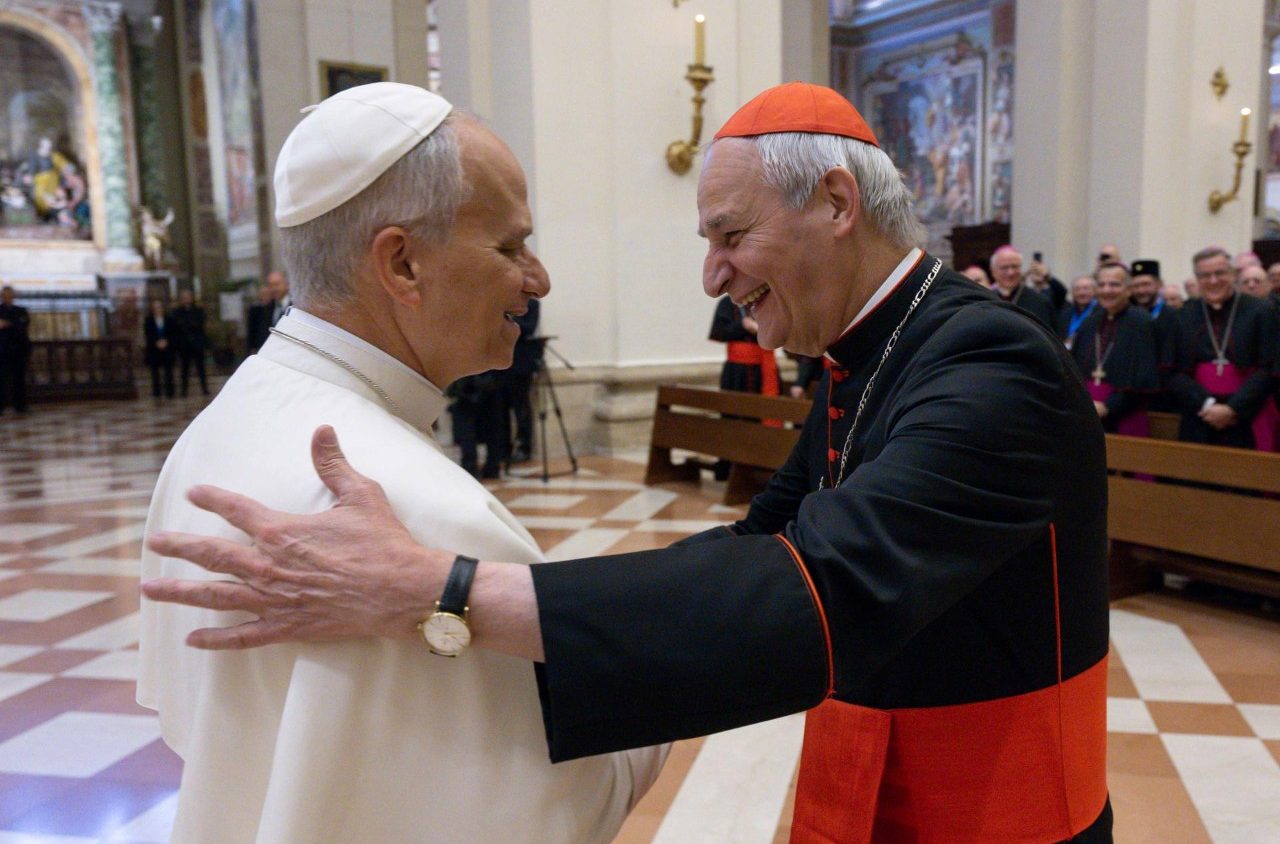Assisi – This morning Pope Leo XIV concluded the work of the 81st General Assembly of the Italian Bishops’ Conference, meeting the bishops in Assisi and delivering a structured, incisive address centered on a return to the Gospel, the building of peace, and the growth of an authentically synodal style within the Italian Church.
The Holy Father arrived in Umbria early in the morning. Before meeting the episcopate, he paused in prayer at the tomb of St. Francis, a gesture carried out in a discreet and private manner. After the dialogue with the bishops, the Pope moved to the stadium from which he departed for Montefalco, where he celebrated Mass in the Monastery of the Augustinian Nuns. He is now having lunch with the community and will return to the Vatican by helicopter in the afternoon.
A Church that starts anew from the Gospel
Greeting the bishops, Pope Leo XIV first highlighted the significance of the place hosting the encounter: Assisi, a city that “conveys a message of faith, fraternity and peace, which the world urgently needs.” Quoting the Vita Secondaand the Testament of the Poverello, he recalled the revelation Francis received: “to live according to the form of the holy Gospel.” He added, again citing the Franciscan Sources: “Christ, who ‘though rich above all things, chose in this world, together with the blessed Virgin, his mother, poverty.’”
The Pope then stated the direction of his message with clarity: “To look to Jesus is the first thing to which we too are called.” The core of Christian existence, he insisted, is not an activity but a relationship: the relationship with Christ, “crucified and risen.” In a time marked by dispersion and an obsession with efficiency, “it is necessary to return to the foundations of our faith, to the kerygma,” and this applies “above all to us,” meaning the pastors.

Peace as a style, not a slogan
Leo XIV emphasized the link between faith and responsibility toward others. “Keeping our gaze fixed on the Face of Jesus allows us to look into the faces of our brothers and sisters,” he said. His reference to the global context was explicit: we live in a world in which “messages and forms of language imbued with hostility and violence” circulate widely, where the race for efficiency “leaves the most fragile behind,” technology “compresses freedom,” and loneliness “erodes hope.” In this scenario, the Church is called to be an “artisan of friendship, fraternity, and authentic relationships,” without hesitation or fear.
“When the Risen One appears to the disciples, his first words are: ‘Peace be with you’,” the Pope recalled. Peace is therefore not just one theme among many, but the Paschal gift to be shared with all, “so that it may be for everyone.”
The synodal task: real communion, shared decisions
A central section of the address was dedicated to synodality, which cannot be reduced to a method or a temporary season but expresses “the walking together of Christians with Christ and toward the Kingdom of God.”
Leo XIV asked the bishops to work concretely to “give shape to a genuinely collegial Church.” In this context he addressed one of the most delicate issues of recent decades: the merging of dioceses. His request was firm: not to turn back, especially “where the needs of Christian proclamation invite us to go beyond certain territorial boundaries” and join forces. At the same time, he acknowledged the difficulties and “at times disorientation” such processes can generate, encouraging each Region to identify realistic proposals for smaller dioceses with limited resources. Collegiality also requires revisiting the process of appointing new bishops, he added: there is a need for “greater participation in the consultative phase,” coordinated between the Dicastery for Bishops and the Apostolic Nunciature.
“Learning to step aside”: the responsibility of transition
Recalling the normative document issued by Pope Francis, Leo XIV invited the bishops to “learn to step aside.” He reiterated that “the norm of 75 years” for the conclusion of an Ordinary’s service should be respected, and that only for cardinals could a two-year extension be considered. A Church that seeks to be synodal cannot cling to roles as private possessions, nor allow “inertia to slow necessary changes.”
One example concerns the Archbishop of Assisi-Nocera Umbra-Gualdo Tadino and Foligno. The extension of his mandate had been decided by Leo XIV’s predecessor, who tended to confirm those he regarded as reliable, aligned, or otherwise unproblematic for governance. Leone did not appreciate finding the decision already made. In recent days, the prelate—whose age has shown its weight—has revealed the challenges facing a diocese already marked by critical issues, compounded by those of Foligno, entrusted to him in persona episcopi with complex results.
Particularly poorly received among the bishops was the Archbishop’s remark during the Assembly, when he pointed out that he was pastor of the hosting diocese but had not been mentioned in the official greetings. One bishop, known for his irony, commented: “I understand he feels overshadowed here by all the Franciscan presence, always ending up in the second row, but still—let’s not overdo it.”

Living memory, integral humanism, and the digital challenge
Leo XIV situated the work of the CEI within the ongoing Italian Synodal Path and the post-conciliar season marked by major national ecclesial gatherings. He urged the bishops to preserve memory within communities, because “remembering the journey the Lord allows us to make” is essential.
The direction is that of a Christianity promoting an integral humanism capable of defending the dignity of life, care for creation, legality, and solidarity. Within this framework lies the challenge of the digital world, which must be inhabited in a truly human way: pastoral work cannot be reduced to using media, but must educate to responsibility, so that the digital sphere becomes a “space of freedom and fraternity.”
Concrete closeness and a culture of prevention
Among the strongest passages was the one dedicated to the most vulnerable: families, young people, the elderly, and those who are alone. The Pope expressed gratitude for the widespread work of Caritas and countless volunteers. But he also firmly recalled the commitment to combating abuse: “Welcoming and listening to victims is the true mark of a Church” that lives conversion and “knows how to recognize wounds.” “Where pain is deep, hope born of communion must be even stronger,” he said.
The example of Francis, the path of the Church
In closing, Pope Leo XIV returned to the Franciscan model. He recalled how the first friars already lived, in the 13th century, that “synodal style” the Church is rediscovering today: “Together… they refined and enriched the initial text” of the Rule, composed “largely of Gospel expressions.” From Assisi, he concluded, must come the strength for “choices inspired by authentic faith,” so that the Church may truly be a sign of the Kingdom of God in the world.
With this, the 81st General Assembly of the CEI comes to a close: intense days marked by clear words and operational guidelines outlining the path ahead. After celebrating and sharing lunch with the Augustinian nuns of Montefalco, Pope Leo XIV will return to the Vatican, leaving the bishops with the task—and responsibility—of turning listening into concrete pastoral decisions.
f.M.S. and F.P.
Silere non possum